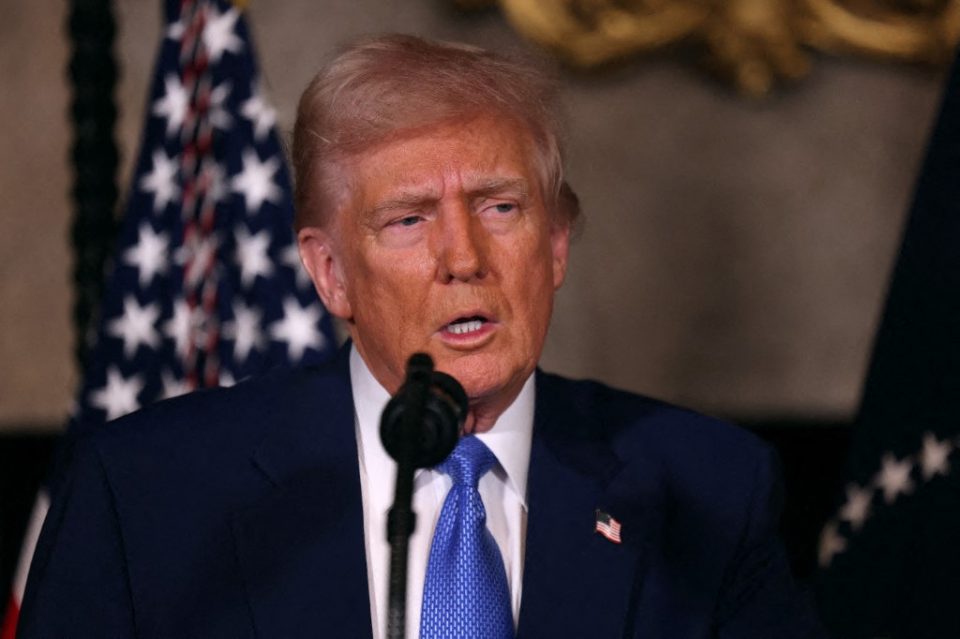Photo caption: US President Donald Trump: Credit AFP
President Donald Trump on Tuesday demanded that Iranian forces unconditionally lay down their arms as he issued a thinly veiled threat that American forces may target Iran’s head of state if the Islamic Republic doesn’t cease targeting Israeli civilians — or targets any American forces in the region.
In a post on Truth Social, Trump wrote that the U.S. “know exactly where” Iran’s “so-called Supreme Leader,” Ayatollah Ali Khamenei, is “hiding” and described him as an “easy target” who is currently “safe” in his current location.
“We are not going to take him out (kill!), at least not for now. But we don’t want missiles shot at civilians, or American soldiers,” the president continued before adding: “Our patience is wearing thin. Thank you for your attention to this matter!”
In a second post moments later, he added another two-word demand: “UNCONDITIONAL SURRENDER!”
The president’s social media comments came less than an hour after he wrote that “we” — an allusion to the American makers of Israel’s military equipment — had achieved “complete and total control of the skies over Iran,” citing the superiority of Israel’s “American made, conceived, and manufactured ‘stuff’” over Iran’s “good sky trackers and other defensive equipment” of non-American origins.
Trump and his administration have steadfastly denied any American involvement in Israel’s days-old campaign to cripple the Iranian nuclear program by destroying nuclear sites, targeting scientists for assassination, and taking out military leaders and much of Iran’s military capabilities.
When Israel began striking Iranian targets last week, multiple administration officials, including Secretary of State Marco Rubio, stressed that the U.S. was not participating and maintained that American forces in the region were being deployed in what has been described as a defensive posture.
But Trump’s ratcheting-up of his rhetoric — and the deployment of more American forces to the region — strongly suggests that he may be considering joining the Israeli effort to take down Tehran’s nuclear program.
While Israeli forces have reported significant successes in taking out numerous targets associated with Iranian atomic weapons research and development, one obstacle that remains is the Fordow enrichment facility, located deep inside a mountain near the city of Qom.
Because the facility is deep underground, successfully destroying it would require dropping so-called “bunker-buster” munitions into the facility from heavy bomber aircraft.
Israeli forces do not possess such weapons, but the United States does.
Destroying the Fordow facility would likely involve use of a B-2 stealth bomber to a Massive Ordnance Penetrator, known by the Air Force designation GBU-57A/B.
The 30,000 pound projectile was designed specifically to attack and destroy hardened facilities such as Fordow, especially those that could house weapons of mass destruction.
The escalating rhetoric from the president comes less than a day after he cut short his visit to the Group of Seven summit in Alberta, citing the situation in the Middle East.
Earlier in the day on Monday, Trump told reporters that he believed he could still broker a diplomatic agreement to curb Tehran’s nuclear ambitions despite the Israel effort to accomplish the same by force of arms.
“I think Iran basically is at the negotiating table where they want to make a deal, and as soon as I leave here, we’re going to be doing something,” he said.
Later in the day after his departure was announced, he explained his decision to reporters who asked about it during a “family photo” with other G7 leaders.
He replied: “I have to be back.”
The president added, “You probably see what I see and I have to be back as soon as I can.”
But in the hours following his departure, U.S. defense officials ordered the USS Nimitz carrier group, including five Arleigh Burke-class guided missile destroyers and other support ships along with an entire carrier-based air wing, to depart the South China Sea and join the USS Carl Vinson strike group deployed in the Arabian Sea.
The aging nuclear-powered vessel is part of a wider buildup of firepower that has seen dozens of U.S. Air Force refueling planes transfer to Europe, two destroyers in the Mediterranean move closer to Israel, and military families at U.S. bases in the Middle East given permission to fly home for their safety.
Separately, the State Department updated a travel advisory for Israel, Gaza and the West Bank territory to “do not travel” as casualties mount on both sides of Israel’s escalating war with Iran.
“The security situation in Israel, including Tel Aviv and Jerusalem is unpredictable, and U.S. citizens are reminded to remain vigilant and take appropriate steps to increase their security awareness as security incidents, including mortar and rocket fire and armed UAV intrusions and missiles, can take place without warning,” the advisory said.
=== INDEPENDENT ===



